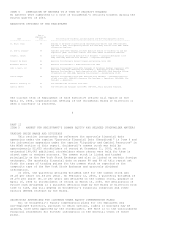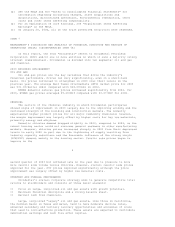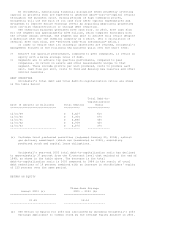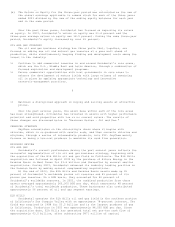Occidental Petroleum 2003 Annual Report Download - page 17
Download and view the complete annual report
Please find page 17 of the 2003 Occidental Petroleum annual report below. You can navigate through the pages in the report by either clicking on the pages listed below, or by using the keyword search tool below to find specific information within the annual report.years, the NYMEX gas price has averaged $3.00 per Mcf.
13
CHEMICAL
The chemical business has been profitable historically; however, the
average level of earnings has declined over the past several years. The major
factors that have an impact on the performance of this business are general
economic conditions, including demand for chemical products, energy and
feedstock costs, and the effect of changes in available capacity.
Over the last five years, the U.S. chemical industry and its primary
market, the U.S. based manufacturing industry, have faced significant
challenges. Foreign competition continues to make price increases by the U.S.
manufacturing industry difficult to achieve. In the chemical industry,
increasing natural gas prices, which affect U.S. electricity prices, have
sharply reduced, and in many cases eliminated, the domestic chemical industry's
natural advantage of proximity to its markets. This has affected basic commodity
chemicals such as caustic soda, chlorine and PVC, but is particularly
significant for niche specialty products such as resorcinol, mercaptans and
antimony-based products. As a result, the U.S. based chemical industry is facing
increasing pressure from competitors in both domestic and export markets. Export
sales accounted for approximately 17 percent of Occidental's 2003 chemical
sales.
The end of the most recent recession and resultant world economic recovery
is expected to improve the overall outlook.
Construction of LNG terminals on the U.S. Gulf Coast could stabilize
natural gas prices at a lower-than-current level and thereby help improve the
competitive position of efficient Gulf Coast chemical facilities. However, this
may not occur in the immediate future. Although Occidental's chemical business
is profitable, if U.S. manufacturing becomes non-competitive on a worldwide
basis, this could shorten the estimated productive lives of some of Occidental's
plants, resulting in higher annual depreciation. Significantly shorter
productive lives could also result in asset impairments, including plant
closures. It is unlikely that any changes in estimated productive lives would be
uniform. While potential impairment charges could have a material impact on the
earnings in a discrete period, such changes are unlikely to have a material
effect on Occidental's overall financial situation.
For additional discussion of the possible financial effect, please see the
"Critical Accounting Policies and Estimates" section below in the MD&A.
CHLOR-ALKALI
Further improvement in chlor-alkali operating rates is expected in 2004 and
beyond as domestic demand for chlorine and caustic soda is forecasted to
increase 2 percent in 2004. PVC and other downstream derivatives are leading the
growth in demand for chlorine. Demand growth for caustic soda is expected to
track closely with overall manufacturing activity.
With increasing demand and improved capacity utilization, pricing for
chlorine is expected to continue to rise compared to 2003. Caustic soda prices
should also improve as overall manufacturing demand strengthens.
VINYLS
Gross domestic product (GDP) growth in the latter part of 2003 and
consensus forecasts of 2004 GDP growth exceeding 4 percent for North America are
encouraging and suggest a strengthening in the economy that will favorably
impact chlorovinyls. Overall, Occidental expects 2-percent growth in vinyls
demand in North America in 2004. PVC and VCM operating rates are expected to
move upward during the year, also averaging 2 percent higher than 2003 rates.
Chlorovinyls supply constraints, together with high energy costs, have
created conditions for vinyls price increases early in 2004. Resin producer
price increases of 2 cents per pound have taken effect for January, and a second
2 cents per pound increase has been announced for February. In addition, VCM
intermediates are expected to be in shorter supply than PVC because of industry
capacity reductions and maintenance requirements. Average operating rates for
North American VCM producers are expected to exceed 90 percent.
The increased demand for chlorine and tighter VCM supplies, due to capacity
























